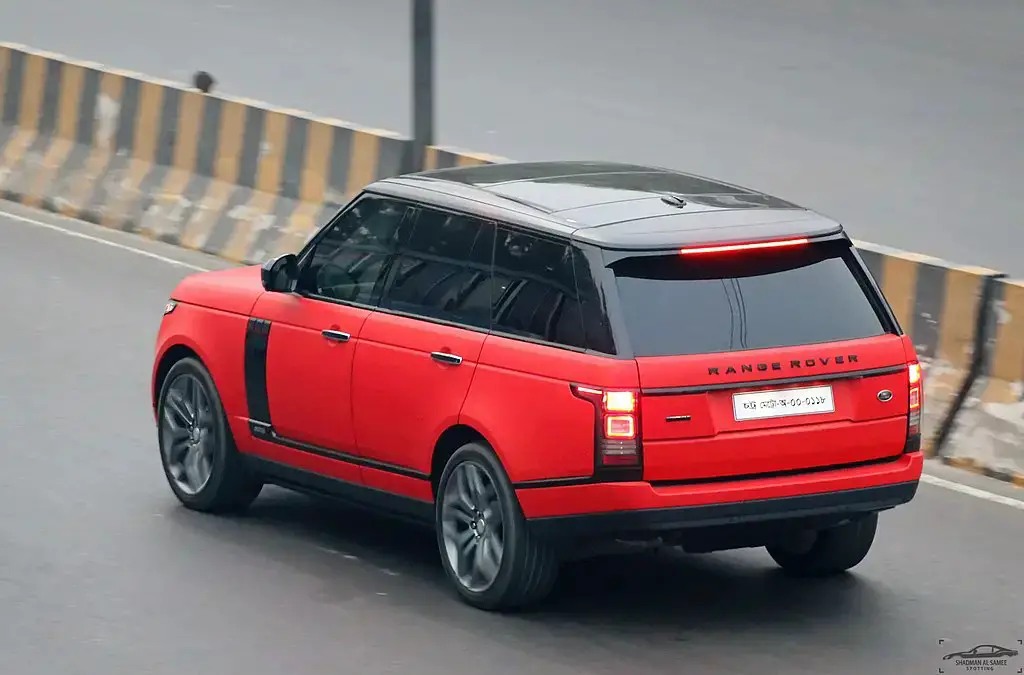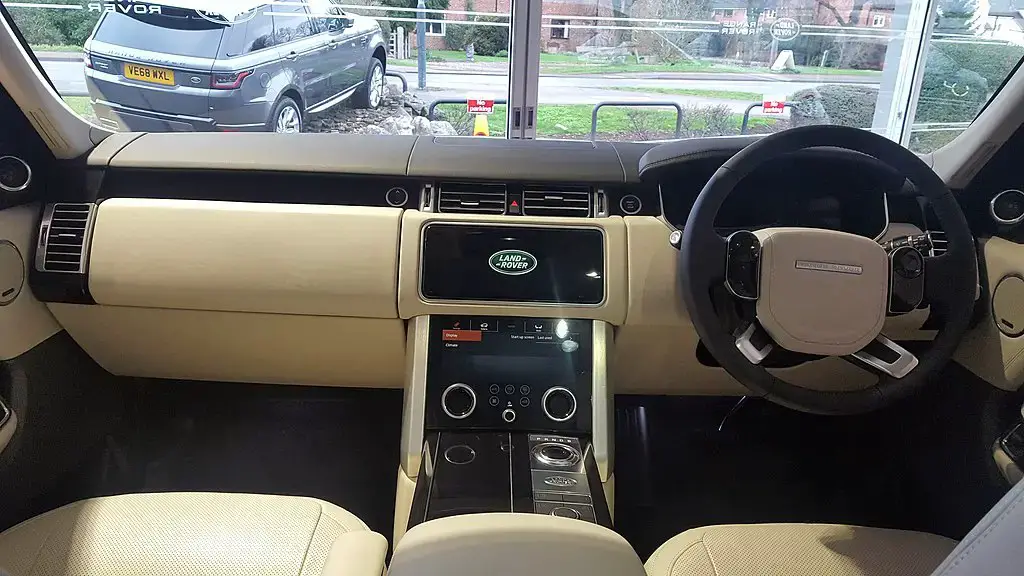Review : Range Rover L405 ( 2012 – 2021 )

You’d think it’s blasphemy to mention the Range Rover L405 here, a car that started at 100,000 pounds + VAT, but you’ll immediately find out why it’s an almost car.
Otherwise known as the official car of buying it new and driving it until the warranty expires. I think you’re already starting to get the idea behind the Range Rover L405. I for one say that this is a marketing strategy, to have a particularly exclusive clientele and to weed out the wannabes. People who only buy them from us and who only drive new cars and keep out those can’t do otherwise and should stay away from the Range Rover L405, even as a used purchase.
Launched in 2012 as a “New Year, New Me”, Range Rover L405 came with a lot of technology and opulence to take our eyes and money. It can be seen that it is no longer the established wheeled fridge like the previous generations P38 and LR322 were, but now it wants to be a city car but capable of off-roading as well. Because anyway not many people drive an L405 in the field, they will be mostly driving on tarmac on the way to repair shop. Mostly because there is also alot of driving to the repair shop but on the platform.
Why so much hate?
Because I’m going to tell you a actual story. Range Rover L405, bought at the dealership brand new. 135,000 euros. Cash. The car returns to the dealership after 2 weeks, 5600 kms on the clock, with what’s left of the engine. And it’s not the only case, because the L405 came under the motto “you only buy it new and keep it strictly during the warranty period”.
But maybe this the true face of its charm and motto, a car so expensive to buy and run that only the genuinly rich will afford one, even as a used purchase. Maybe with an LR322 you can get away with a 3.0 diesel from BMW if you are broke and a 3.6 V8 diesel if you are somewhat wealthy, but for the L405 there is no cheap option. Just as there is no “cheap” Range Rover in terms of equipment and trim levels, there is so much wood and so much fur and so much leather that this car feels like a wheeled Langham Hotel and you have your own bar in the car and overall we have the last word in terms of luxury, if you’re willing to pay for it. I would talk more about this, but I need alot of writing space in the engines and issues sections.

Range Rover L405 Engines
Petrol
- 3.0 V6 supercharged Ingenium of 340 and 380 horsepower – We start with the Ingenium engine, which was also installed on the Jaguar XE and which is probably the most reliable engine on the Range Rover L405. Basically an evolution of the old 3.0 Ford Duratec / Jaguar AJ-8 engine just updated for 2012 and it’s also basically the 6 cylinder version of the 5.0 V8 monster. They even kept all the auxiliaries of the 5.0 V8 so they are extra resistant to the lower amount of punishment from the engine.
- 5.0 V8 AJ133 of 375 horsepower – I didn’t necessarily understand why they offered a naturally aspirated 5.0 V8 on sale next to the supercharged version, but ok.
- 5.0 V8 Supercharged AJ133 of 510, 525, 550 and 565 horsepower – Now we’re talking, the 5.0 Supercharged V8 of 1 million horse power. The engine is taken straight from the LR322 / Jaguar and bolted on the L405, with some updates on the emissions side. It’s the only engine worth buying because it’s reliable by Land Rover and Range Rover standards, and the L405 is a car of excess anyway.
Diesel
- 3.0 TDV6 AJD of 250, 258, 275, 300 horsepower – This engine lasts about 80-100,000 km, but I have seen it kick the bucket at 5,600 km, so that’s that. But then again you own a Range Rover L405, you either take it like that or it doesn’t hurt you because the warranty will pay. This engine is unfortunately famous for ripping apart it’s timing chain and it’s camshaft or it’s starved of oil and it seizes. But then again, these are worldly problems, not worth your time.
- 4.4 V8 AJD of 340 horsepower – You may find it risible, but this engine is much more reliable than the 3 litre. As long as it doesn’t lose oil and turbos like I lost my clothes and wallet and phone when I went drinking at the Wellington. I woke up the next day, on the wooden floor of the terrace. It was cold. But the ale was really something else and by this maybe they will offer me a pint on the house but that’s not very probable. But overall it is decently reliable because it was clear that only large and excessive engines must be worthy of the Range Rover.
Hybrid
- 2.0 Ingenium petrol hybrid PHEV of 398 horsepower – I don’t know why you would buy a P400e, but you better be awake when you pull the trigger. The electric only range is 15 miles, after which the entire weight of the L405 is carried by a 2.0 petrol. Good luck with that. Not to mention the reliability issues of the hybrid system and the fact that sometimes it forgets to charge (it’s a plug-in hybrid). Or if you ran out of electricity, you are left stranded. Be a real man or woman and get a 4.4 V8 diesel. However the P400e is a serious contender to the 3 litre diesel but I don’t have enough writing space for this discussion, but if I were to choose between a 3 litre diesel and the P400e, my imaginary money would be on the P400e.
- 3.0 Ingenium diesel hybrid of 340 horsepower – In their immeasurable genius the hybrid system and the engine run on the same circuit and when the hybrid system fails (not if but when) the engine doesn’t start either. Honestly, I don’t see why you would buy a 3.0 hybrid diesel because you save abit on taxes and insurance but you’ll get way more shagged in the parts and running costs department.

Range Rover L405 Reliability Issues
- Everything that is electrically operated can and will definitely fall. It’s only a matter of time.
- It’s a heavyweight and you shouldn’t be surprised in any way by the fact that the suspension gives up quickly, from the arms to the airbags. Because it’s got standard air suspension, coilovers are for people beneath your status.
- Worryingly there is a more serious problem caused by bad electricals. The Range Rover Sport was the most stolen car in England consistently for the past few years and the Range Rover Vogue is keeping the pace with the Full Fat Range Rover. And this brings up another problem, as there are currently massive issues with insuring a Range Rover, as the Range Rover is so easy to steal. Either the quotes are comical, or they flat out refuse to insure it.
- Bootlid and door hinges are not strong enough for the weight, so you will see that the doors are not exactly aligned with the rest of the body and are sagging. That is if you care about the body panels being aligned on a 100k+ pounds car.
- The rear differential has a tendency to fail even when it is only used for school runs.

Range Rover L405 Verdict
Maybe I’m too harsh on the L405. But here comes a question. If you spend 150-200,000 pounds on a car, you would expect top-notch quality. I get that when you spend 200,000 pounds on a car, an 10,000 pound service invoice won’t mean much of antyhing, but you still want some degree of quality and reliability for this money. And not returning to the dealership with the car on the platform, with what is left of the engine and with only 5600 km on the clock. But when it does however you have basically an S Class that can go anywhere, from London to Everest and back through the African savannas.
Which engines do I recommend? For the Range Rover it’s either the 5.0 V8 Supercharged 525 horsepower petrol or the 4.4 V8 diesel because only the V8 is really decent and suitable engine for the character of the legendary Range Rover L405.
Similar Articles

Review : Toyota Verso AR20 ( 2009 – 2013 )

Review : Skoda CitiGO ( 2011 - 2020 )

Review : Seat Mii ( 2011 - 2020 )
Write an answer
- Review : Toyota Verso AR20 ( 2009 – 2013 ) 10 November 2025
- Review : Skoda CitiGO ( 2011 - 2020 ) 02 August 2025
- Review : Seat Mii ( 2011 - 2020 ) 02 August 2025
- December 2025
- November 2025
- October 2025
- August 2025
- July 2025
- April 2025
- March 2025
- February 2025
- January 2025
- December 2024
- November 2024
- October 2024
- August 2024
- July 2024
- June 2024
- May 2024
- April 2024
- March 2024
- February 2024
- January 2024
- December 2023
- November 2023
- October 2023
- September 2023
- August 2023
- July 2023
- June 2023
- May 2023
- April 2023
- March 2023
- February 2023
- January 2023
- December 2022
- November 2022
- October 2022
- September 2022
- August 2022
- July 2022
- June 2022
- May 2022
- March 2022
- April 2021
- January 2021
- December 2020
- November 2020
- October 2020
- September 2020
- August 2020
- July 2020
- March 2020